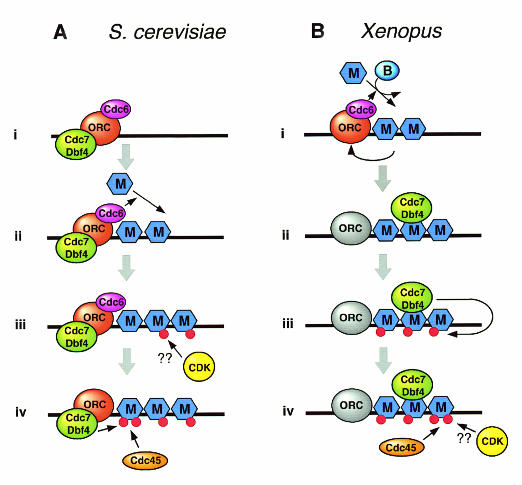Fig. 1. Comparison of proposed Cdc7/Dbf4 function in S. cerevisiae and Xenopus. (A) Events occurring at an S. cerevisiae replication origin, taken from Pasero et al. (1999), Nougarede et al. (2000) and Zou et al. (2000). ‘M’ refers to the Mcm(2–7) heterohexamer. (i) Cdc6 and Cdc7/Dbf4 bind independently to ORC at a replication origin. (ii) Cdc6-dependent loading of Mcm(2–7) onto origin. (iii) CDK-dependent step, possibly phosphorylation of Mcm(2–7), that must occur prior to Cdc7/Dbf4 function. (iv) Cdc7/Dbf4 function [most likely Mcm(2–7) phosphorylation] leads to assembly of Cdc45 onto the origin. (B) Events occurring at a Xenopus replication origin, taken from Jares and Blow (2000). ‘M’ refers to the Mcm(2–7) heterohexamer, and ‘B’ refers to RLF-B component of the replication licensing system. (i) The loading of Mcm(2–7) proteins onto DNA (origin licensing), which depends on the function of ORC, Cdc6 and RLF-B, causes displacement of Cdc6 and destabilization of ORC. (ii) Cdc7/Dbf4 recruitment to the origin requires the Mcm(2–7) but not ORC or Cdc6. (iii) Cdc7/Dbf4 phosphorylation of Mcm(2–7) can occur in the absence of CDKs. (iv) Loading of Cdc45 onto the origin depends on both Cdc7 and CDK activity.

An official website of the United States government
Here's how you know
Official websites use .gov
A
.gov website belongs to an official
government organization in the United States.
Secure .gov websites use HTTPS
A lock (
) or https:// means you've safely
connected to the .gov website. Share sensitive
information only on official, secure websites.
